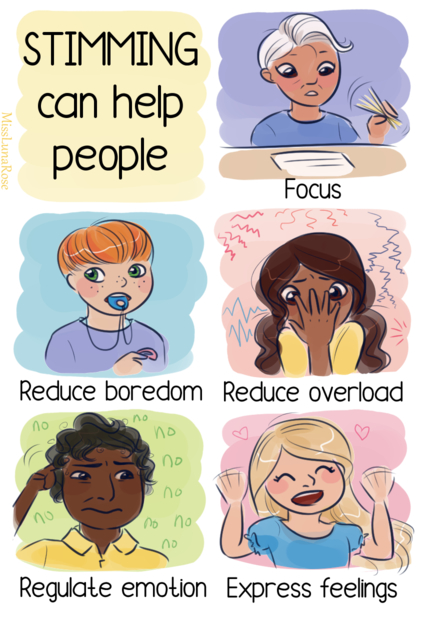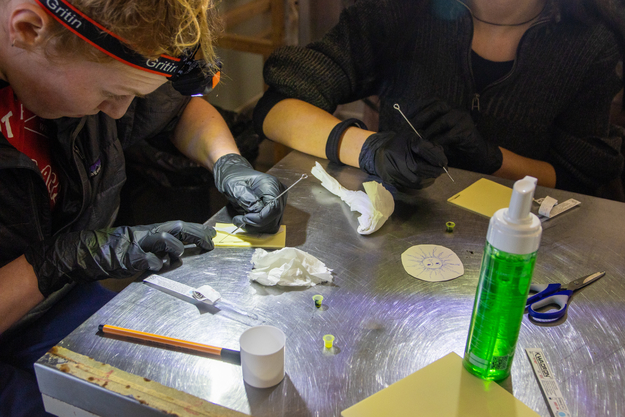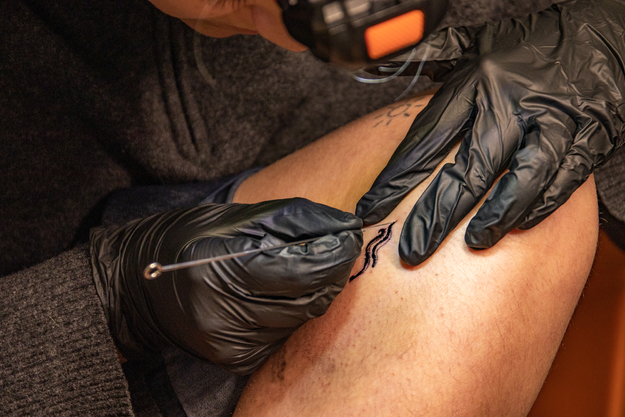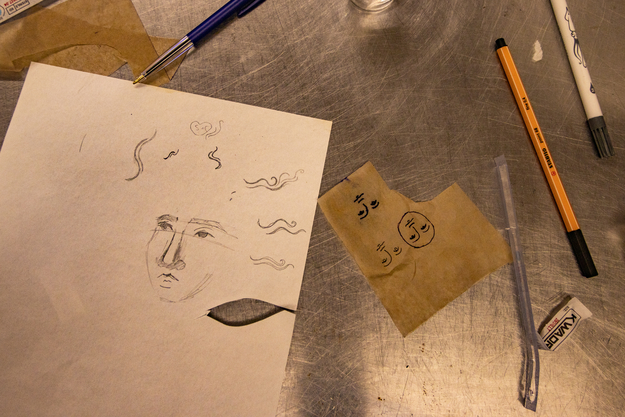Reflecting on "Tattoo your Skin ~ Soothe your Mind" Workshop
What did we learn about the Link between Neurodiversity and Tattoo Culture?
For the last three months, I (Lynn Clemens (she/them)) hosted my "Tattoo your Skin ~ Soothe your Mind" workshop.
The workshop was a means to further research the hypothesis that I came up with during my internship for the A/artist project; the links between neurodiversity and tattoo culture as documented in my blogpost "The Links between Tattoo Culture and Autism". My main idea was that giving as well as receiving tattoos function as stimming - self-stimulatory behaviour in the name of anxiety reduction, which you can read about more in the former mentioned blogpost.
During the workshop, participants have been guided by me in the role of A/artist project assistant and tattoo enthusiast on how to give themselves stick-and-poke tattoos.
The following article will reflect on the workshop.
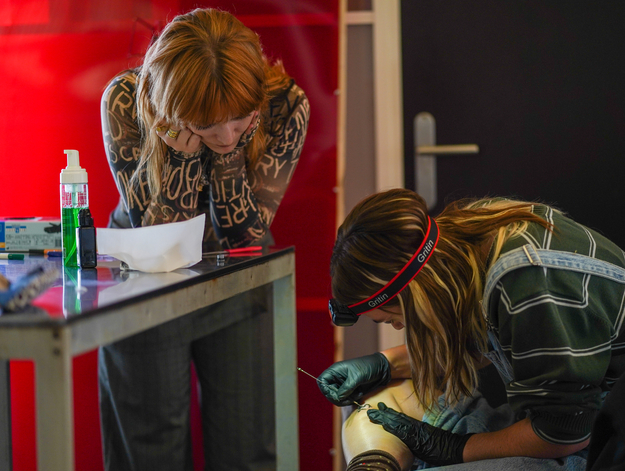
Lynn watching over a participant during their workshop "Tattoo your Skin ~ Soothe your Mind" -
Framework
The hypothesis that sprung the idea of researching the links between tattoo culture and neurodiversity was my own experience of giving stick-and-poke tattoos as a way of stimming.
The latter is most frequently associated with neurodivergent people that engage in self-stimulatory behaviour in order to reduce anxiety linked how their neurodivergent brain operates. Stimming is defined as repetitive behaviour that can reach anywhere from humming, fidgeting, foot tapping to art or playing music. It has been established that the neurodivergent brain oftentimes is prone to be overstimulated by unpredictable bottom-up stimuli in the environment and stimming occurs as an effort to counter and block this out by establishing a top-down predictable input that they both create and feel themselves.
However, the most important point I stressed throughout my workshops is that everyone - also neurotypical people stim. Hence, the responses from the neurotypical people are still valuable for this research question of how the tattoo culture specifically links to stimming. Please read more about the theory in my blog post.
Each workshop would start with my presentation, in which I shared my experience as an autistic person with ADD in order to familiarise the participants with the concepts of neurodiversity - specifically stimming - as well as the A/artist project's aims.
Once everyone was one the same page, I shared the main arguments from my blogpost "The Links between Tattoo Culture and Autism" to convey a broad idea of the links between tattoo culture and autism that have been hypothesised so far.
However, given that our knowledge on the topic is yet quite limited, I prepared a research questionnaire (second page here) and asked participants to fill it out after each workshop.
Tattoo your Skin ~ Soothe your Mind Research Questionnaire - Tattoo your Skin ~ Soothe your Mind Research Questionnaire (2/2) - 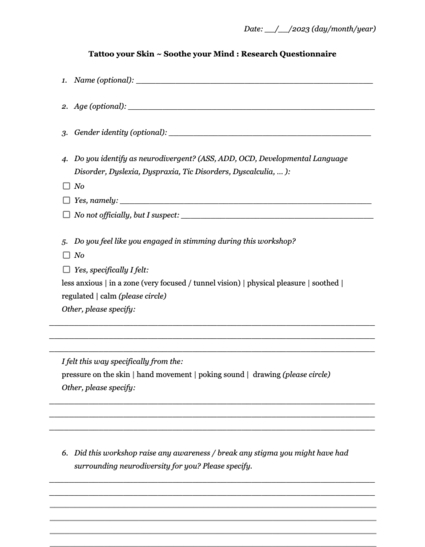
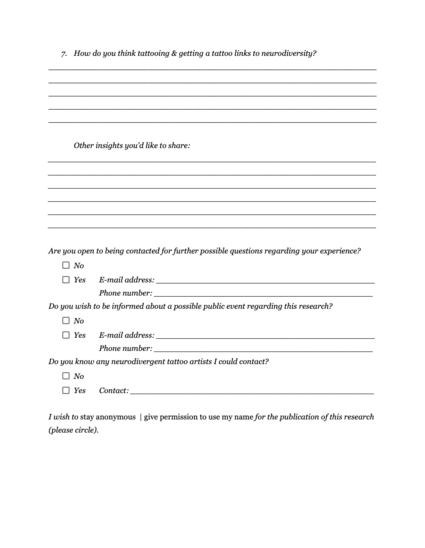
Findings
Participants
Out of the 25 participants, 24 filled out the questionnaire and 2 unfortunately missed the second page of it.
The age of participants ranged from 20-59 with an average of 28, 4 identified as male, 16 as female and 4 did not fill out their gender identity.
Neurodiversity
Given that Mediamatic and me publicised the workshop in the context of neurodiversity, I expected to reach a neurodivergent crowd. However, only 6 of the 25 participants identified as neurodivergent (1 dyslexia, 3 ADD, 1 "sort of" ADD and ASS, 1 both ADD and ASS), with a third suspecting that they might be neurodivergent (5 ADD, 2 autism, 1 dyslexia).
This means that the results from this questionnaire do not testify to the experience of neurodivergent people, but nonetheless to that of people that are educated on the concepts. Overall, I did not find any striking differences between the answers that neurodivergent versus neurotypical participants gave.
Stimming
Given that stimming was my main hypothesis behind the links between tattoo culture and neurodiversity, I was content to read that all but one participant agreed that they engaged in stimming during the workshop.
Regarding the exact experience of stimming, 16 participants said to have felt "in a zone (very focused / tunnel vision)". The one participant who did not stim during the workshop explained that they felt too perfectionist to really "enter such a zone". This is quite interesting given that some participants noted that they felt in such a zone due to "perfecting the image, correcting 'mistakes'" and from "doing a task and wanting it perfect".
Many felt calm during the tattoo process, less anxious and felt physical pleasure from tattooing themselves.
A few shared to have felt a "zone of tranquil and excitement", "creative and in command", "not overthinking and not overloaded". Four other participants stressed that the tattooing gave them a full body experience in which their mind went quiet.
13 felt especially so from the hand movement, many from the pressure they felt on their skin, and only a few from the drawing process and the poking sound that poking the skin makes.
Awareness
Considering how this workshop raised awareness surrounding neurodiversity, I was immensely happy to hear that 19 out of the 24 participants that replied to this question ticked "yes".
12 people said they enjoyed learning about stimming, one writing: "inspiring how you told you story at intuitively being drawn to tattooing".
The finding that 6 participants felt more connected to neurodivergent people after my workshop touched me personally. They said that they learned that we are all human and that neurodiversity is just another factor that makes a person who they are. Moreover, they mentioned that they realised they stim just like neurodivergent people would - as one participant stated the "meditational state" achieved during tattooing "helps understanding that people with different neuronal setting can achieve a common level of ease". Moreover, some shared that art is what connects neurodivergent and neurotypical people.
Interestingly enough, one undiagnosed participant even reflected: "I enjoyed learning about what ADD means for somebody, maybe I have it myself. I recognise things you said about ADD in myself".
Stick and Pokes is a form of tattooing, different to tattoos made with gun. They are also called hand poke tattoo, because the artist holds one single needle that they put into the skin, dot by dot. Thus, generally this form of tattooing necessitates more layers as the hand is slower than the machine that shoots dots at a rate faster than what the eye can see. By: Lynn (she/they) Clemens
Links
Stimming:
With regards to what participants think the link between neurodiversity and tattoo culture might be, 14 answers can be classified under stimming, with 4 direct uses of the word stimming.
Indirect alluding to stimming were consistency, repetition and rhythmic movement, which is reminiscent of the definition of stimming behaviour.
Yet another person mentioned that focusing on only one thing might make one's surroundings disappear, which translates to blocking out excessive input through self-inflicted predictable input.
Moreover, some believed that tattooing is reminiscent of feelings of regularity and stability which can be a useful tool for neurodivergent people.
Art:
7 people saw art as a possible link between tattoo culture and neurodiversity. We know that neurodivergent people tend to gravitates towards art. Two responses stood out to me, made by neurodivergent participants:
"tattooing means self-expression and art means getting in a zone" (dyslexia)
"neurodivergent people are more impulsive and therefore more open to art" (ADD).
Physical Pleasure:
3 people mentioned the physical pleasure that neurodivergent people might get from receiving a tattoo, which connects to the fact that neurodivergent people have different pain perception and some prefer hard over soft touch.
Control:
Lastly, three people mentioned that they believe tattooing is a way to regain control for neurodivergent people, which has been affirmed by autistic tattoo artists.
Collecting:
One person mentioned "it is interesting to use your body as a canvas plus i can imagine it is on becomes part of your identity". Another person further strengthened this point by mentioning that they believe that tattoos are a way of collecting art on your body - to which neurodivergent people are especially drawn.
General Feedback
I am so proud to say that every feedback Mediamatic received for my workshop was positive.
"The workshop was really well informed on the subject, host did not shy away from sharing own experiences and thereby created a very comfortable space to get creative"
"I enjoyed the presentation of the overall project, the explanation of neurodiversity and the overall approach of Lynn. They made it an informative and especially fun session, where I felt I learnt a lot! Also kudos for all the great attention to hygiene rules, better than many tattoo studios."
"Thank you for establishing the link between tattoo culture and neurodiversity. So interesting!"
"Thank you for the education"
"I really liked it!"
"Thank you, I really enjoyed it!"
"Amazing job!"
"Nice workshop, nice introduction to stick-and-poke"
"It was a nice experience. Thanks"
Conclusion
In conclusion, I believe it is safe to say that the workshops have been a success both measured by participants' satisfaction and the information we gained regarding the links between tattoo culture and neurodiversity.
Generally, all hypotheses from my previous article have been confirmed and strengthened. Imperatively, it has been established that stick-and-poke tattoos indeed work as a form of stimming for both neurodivergent and neurotypical people. Perhaps a way to bring us closer to each other and evaporate stigma.
I thank Mediamatic for giving me the opportunity and the trust as an intern to live out my skills acquired before my time at Mediamatic in the form of workshops that are so dear to me due to the personal connection I have to both neurodiversity and tattoos.
